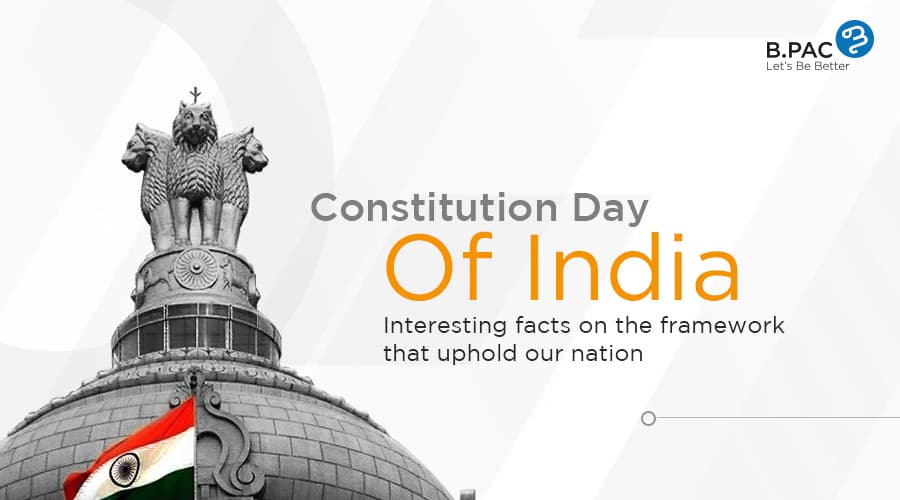Interesting facts on the framework that upholds our nation
“However good a Constitution may be, if those who are implementing it are not good, it will prove to be bad. However bad a Constitution may be, if those implementing it are good, it will prove to be good.”
Dr. BR Ambedkar
Every nation has a written constitution that summarises and sets forth its guiding ideals and systems of government. For our country, it is the Constitution of India which forms the foundation of our land. Additionally, it not only solidly unites the nation’s diversity and diverse cultures, but it also strengthens and protects citizens’ rights and liberties while preserving an efficient balance between the many government agencies. The established beliefs prevent the abuse of power by authorities and restrict the concentration of power in the hands of one governing body. The set of regulations reflects the standards Indians hold their government to. They include the form of government the nation should have and the ideals it ought to uphold.
To commemorate the adoption of the Indian Constitution, November 26 is recognised as National Constitution Day or Samvidhan Diwas or National Law Day. On November 26, 1949, the Constitution was ratified, and on January 26, 1950 it came into effect. Let’s look at some of the interesting yet lesser known facts about the Indian Constitution on this particular occasion.
Some Interesting Facts about our Indian Constitution
1- From Thought To Action
The first person to call for an Indian Constituent Assembly was M.N. Roy, an Indian Revolutionary and radical activist, in 1934. In a resolution that rejected a British proposal known as the “White Paper” on constitutional reforms for India a year later, the Indian National Congress made this an official demand. This resolution would later be enacted as the Government of India Act 1935.
2- A Handwritten Constitution
The Indian Constitution is not written or printed. Both Hindi and English versions are calligraphed by hand by Prem Behari Narain Raizada in flowing italic style, who also published it himself in Dehradun.
3- Illustration Of Constitution:
Every page of the handwritten Indian Constitution and the Preamble page have been embellished by Shantiniketan painters including Beohar Rammanohar Sinha and Nandalal Bose.
4- The Time It Took In The Making
To be precise, it took 2 years, 11 months, and 18 days to complete the final draft of the Indian Constitution which came into force with a total expenditure of ₹6.4 million.
5- More Than 2000 Amendments In First Draft
A total of 2,475 amendments were made to the original draft. 284 members of the Constituent Assembly accepted and signed the Constitution. The Constitution included 395 Articles, 8 Schedules, and 22 Parts at the time of the last sitting of the Constituent Assembly on January 24, 1950. There are currently 470 articles divided into 25 parts, 12 schedules, and 5 appendices.
6- Bag Of Borrowings
The Indian Constitution is frequently referred to as the “bag of borrowings” since several of its provisions draw their ideas or language from the constitutions of other nations. It was written with consideration for India’s historical perspective, geographical variety, and cultural traits.
- For instance, the concept of legislative procedure, single citizenship, the cabinet system, and bicameralism were all borrowed from the British Constitution.
- The Preamble, Fundamental Rights, Impeachment of the President, Removal of Supreme & High Court Judges, Functions of President and Vice-President, etc. were derived from the Constitution of the United States of America.
- The concept of Ideals of Liberty, Equality, and Fraternity were drawn from the French Constitution’s Preamble.
7- The Longest Constitution In The World
India is renowned for having the longest Constitution in the world in addition to having the largest democracy in the world. It is the world’s longest Constitution at 117,369 words.
8- Preservation Of The Original Constitution
The Library of the Indian Parliament has unique helium-filled cases where the original copies of the Indian Constitution are kept safe to prevent oxidation of ink.
9- From Dominion Of India To Republic of India
The Government of India Act was replaced by the Indian Constitution in 1935. The 1935 Government of India Act serves as the cornerstone for the Indian Constitution. The Dominion of India became the Republic of India when the Constitution took the place of the GOI Act as the primary law of the land.
10- Introduction Of National Emblem
The Lion Capital Of Ashoka became the country’s national emblem on January 26, 1950. The four Asiatic lions stand for strength, courage, pride, and confidence.
11- Father Of The Indian Constitution
The chief architect of the Indian Constitution was Dr. Bhimrao Ramji Ambedkar, who is regarded as the father of the Indian Constitution. He is the one who drafted the Indian Constitution after researching the laws of around 60 other nations.
12- Women’s Right To Vote
Only until the Indian Constitution went into effect did Indian women acquire the complete right to vote. Full suffrage for women was introduced in India by the Constitution in 1949.
13- Inception Of The Preamble Of Indian Constitution
Jawaharlal Nehru introduced the Objective Resolution, which later evolved into the Preamble of the Constitution. The words “socialist” and “secular” were added to the Preamble in 1976, during the emergency, thanks to the 42nd amendment. It outlined the fundamental tenets of the Constitution.
14- The First & The Last Signatory
The Indian Constitution was initially signed by Dr. Rajendra Prasad, the country’s first president. The final signatory was Feroze Gandhi, who was the President of the Constituent Assembly at the time.
15- Heart & Soul Of Indian Constitution
Dr. B. R. Ambedkar referred to Article 32 of the Indian Constitution as the “heart and soul” of the document. It grants a citizen the right to file a complaint with the Supreme Court to have any fundamental rights upheld in the event that they are violated. The Right to Constitutional Remedies is another name for it.
16- Mini-Constitution
The Indian National Congress, led by Indira Gandhi, passed the 42nd Amendment Act, 1976, one of the most significant revisions to the Indian Constitution. This statute is also known as “Mini-Constitution” because of the numerous amendments it made to the Indian Constitution. It incorporated sections that sought to curtail the authority of the Supreme Court and the High Courts, outlined citizens’ fundamental duties, and added the preamble terms “socialist,” “secular,” and “integrity.”
17- The Magna Carta Of Indian Constitution
The Indian Constitution’s Part lll is referred to as its Magna Carta. The Magna Carta is the Declaration of Rights that King John of England signed in 1215. It is the first piece of writing to discuss a very long and comprehensive list of ‘justiciable’ fundamental rights for citizens.
Takeaway:
So, what does it mean by the Constitution of India? It is essentially a set of frameworks that binds our nation together, invoking a sense of patriotism and unity that transcends social boundaries. The ideals embodied in the Indian Constitution are built entirely on a solid ethical framework designed to uplift the populace and propel Indian society ahead with a spirit of tolerance and respect for the nation’s diversity.
Despite being a relatively young Constitution, it has undergone through some tremendous changes while demonstrating remarkable resilience to every challenge. Our Indian Constitution is a living testament that proves that the desires of heedless political avarice do not govern the populace; rather, it is the will and the words of the Constitution.
As Dr B. R. Ambedkar aptly states, “The Constitution is not a mere lawyer’s document, it is a vehicle of life, and its spirit is always the spirit of the age!” This Constitution Day, let us understand, embrace and celebrate our Indian Constitution!
Source:





